Database management System NTA UGC NET Question Analysis Part-1
Q.1➡ | UGC NET DEC 2023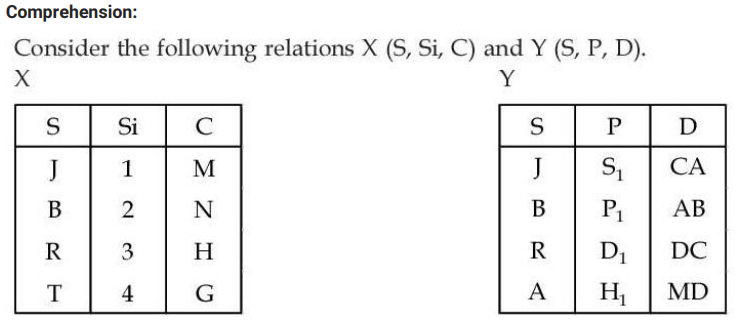 Question- |
i ➥ 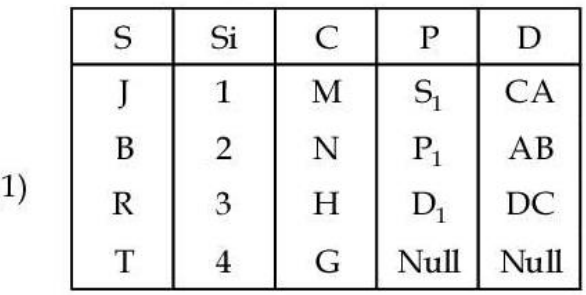 |
ii ➥ 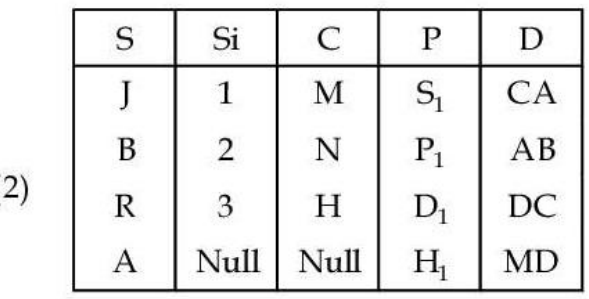 |
iii ➥ 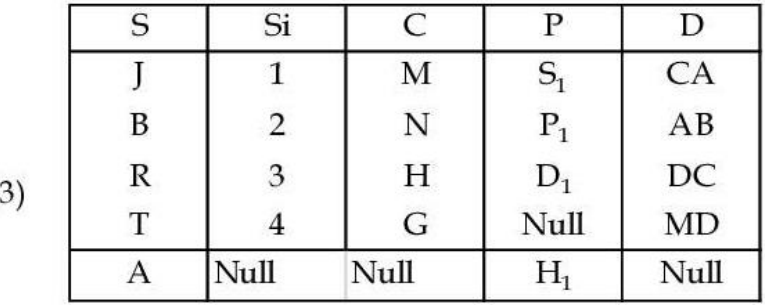 |
| iv ➥ None of these |
| Best Explanation: Answer: (II) Explanation: Upload Soon |
| More Discussion | Explanation On YouTube | Learn Topic Wise | Help-Line |
Q.2➡ | UGC NET DEC 2023 Number of tuples obtained by applying cartesian product over X and Y are: |
| i ➥ 16 |
| ii ➥ 12 |
| iii ➥ 04 |
| iv ➥ 32 |
| Best Explanation: Answer: (I) Explanation: Upload Soon |
| More Discussion | Explanation On YouTube | Learn Topic Wise | Help-Line |
Q.3➡ | UGC NET DEC 2023 Which of the following join is used to get all the tuples of relation X and Y with Null values of corresponding missing values? |
| i ➥ Left outer join |
| ii ➥ Right outer join |
| iii ➥ Natural join |
| iv ➥ Full outer join |
| Best Explanation: Answer: (IV) Explanation: Upload Soon |
| More Discussion | Explanation On YouTube | Learn Topic Wise | Help-Line |
Q.4➡ | UGC NET DEC 2023 Find the number of tuples by applying the operation |
| i ➥ 1 |
| ii ➥ 3 |
| iii ➥ 4 |
| iv ➥ 6 |
| Best Explanation: Answer: (III) Explanation: Upload Soon |
| More Discussion | Explanation On YouTube | Learn Topic Wise | Help-Line |
Q.5➡ | UGC NET DEC 2023 Number of tuples by applying right outer join on relation X and Y is/are: |
| i ➥ 16 |
| ii ➥ 5 |
| iii ➥ 3 |
| iv ➥ 4 |
| Best Explanation: Answer: (IV) Explanation: Upload Soon |
| More Discussion | Explanation On YouTube | Learn Topic Wise | Help-Line |
| Q.6➡ | UGC NET DEC 2023 2-3-4 trees are B – trees of order 4. They are isometric of trees. |
| i ➥ AVL |
| ii ➥ AA |
| iii ➥ 2-3 |
| iv ➥ Red-Black |
| Best Explanation: Answer: (IV) Explanation: Upload Soon |
| More Discussion | Explanation On YouTube | Learn Topic Wise | Help-Line |
| Q.7➡ | UGC NET DEC 2023 Which one of the following statements are CORRECT ? (A) Granularity is the size of data item in a database. (B) Two operations in a schedule are said to be conflict if they belong to same transaction. (C) Two schedulers are said to be conflict equivalent if the order of any two conflicting operations is the same in both schedules. (D) Write operations which are performed without performing the write operation are known as Blind Writes. Choose the correct answer from the options given below : |
| i ➥ (A) and (B) Only |
| ii ➥ (A), (B) and (C) Only |
| iii ➥ (A), (B) and (D) Only |
| iv ➥ (B) and (C) Only |
| Best Explanation: Answer: (II) Explanation: Upload Soon |
| More Discussion | Explanation On YouTube | Learn Topic Wise | Help-Line |
| Q.8➡ | UGC NET DEC 2023 Which one of the following statements are CORRECT ? (A) Granularity is the size of data item in a database. (B) Two operations in a schedule are said to be conflict if they belong to same transaction. (C) Two schedulers are said to be conflict equivalent if the order of any two conflicting operations is the same in both schedules. (D) Write operations which are performed without performing the write operation are known as Blind Writes. Choose the correct answer from the options given below : |
| i ➥ (A) and (B) Only |
| ii ➥ (A), (B) and (C) Only |
| iii ➥ (A), (B) and (D) Only |
| iv ➥ (B) and (C) Only |
| Best Explanation: Answer: (II) Explanation: Upload Soon |
| More Discussion | Explanation On YouTube | Learn Topic Wise | Help-Line |
| Q.9➡ | UGC NET DEC 2023 Which of the following is/are NOT CORRECT statement? (A) The first record in each block of the data file is known as actor record. (B) Dense index has index entries for every search key value in the data file. (C) Searching is harder in the B+ tree than B- tree as the all external nodes linked to each other. (D) In extendible hashing the size of directory is just an array of 2d-1, where d is global depth. Choose the correct answer from the options given below: |
| i ➥ (A), (B) and (C) Only |
| ii ➥ (A), (C) and (D) Only |
| iii ➥ (A), (B) and (D) Only |
| iv ➥ (A), (B), (C) and (D) Only |
| Best Explanation: Answer: (II) Explanation: Upload Soon |
| More Discussion | Explanation On YouTube | Learn Topic Wise | Help-Line |
| Q.10➡ | UGC NET DEC 2023 Match List – I with List – II. List – I (A) BCNF iff (B) 5 NF iff (C) 1 NF iff (D) 4 NF iff List – II (I) every JD is implied by the candidate keys (II) all underlying domains contain scalar values only (III) every MVD is implied by the candidate keys (IV) every FD is implied by the candidate keys Choose the correct answer from the options given below : |
| i ➥ (A)-(III), (B)-(II), (C)-(I), (D)-(IV) |
| ii ➥ (A)-(IV), (B)-(I), (C)-(II), (D)-(III) |
| iii ➥ (A)-(II), (B)-(III), (C)-(IV), (D)-(I) |
| iv ➥ (A)-(IV), (B)-(I), (C)-(III), (D)-(II) |
| Best Explanation: Answer: (II) Explanation: Upload Soon |
| More Discussion | Explanation On YouTube | Learn Topic Wise | Help-Line |
| Q.11➡ | UGC NET JUNE 2023 Consider the following statements: A. A database design is in BCNF if each member of the set of relation schemas that constitutes the design is in BCNF B. A BCNF schema can have transitive dependency C. It is always possible to obatin a 3NF design without sacrificing a lossless join There are multivalued dependencies in 4NF |
| i ➥ A, B and C only |
| ii ➥ B, C and D only |
| iii ➥ A, B and D only |
| iv ➥ A. C and D only |
| Best Explanation: Answer: IV Explanation: Upload Soon |
| More Discussion | Explanation On YouTube | Learn Topic Wise | Help-Line |
| Q.12➡ | UGC NET JUNE 2023 Given below are two statements: Which of the following concurrency control protocol ensures both conflict serializability and freedom from deadlock? Statement I: Two phase locking Statement II: Timestamp ordering In the light of the above statements, choose the most appropriate answer from the options given below: |
| i ➥ Both Statement I and Statement II are correct |
| ii ➥ Both Statement I and Statement II are incorrect |
| iii ➥ Statement I is correct but Statement II is incorrect |
| iv ➥ Statement I is incorrect but Statement II is correct |
| Best Explanation: Answer: IV Explanation: |
| More Discussion | Explanation On YouTube | Learn Topic Wise | Help-Line |
| Q.13➡ | UGC NET JUNE 2023 Given the basic E R diagram and relational model, which of the the following is incorrect? |
| i ➥ An attribute of an entity can have more than one value |
| ii ➥ An attribute of an entity can be composite |
| iii ➥ In a row of relational table, an attribute can have more than one value |
| iv ➥ In a row of a relational table, an attribute can have exactly one value or a NULL value |
| Best Explanation: Answer: III Explanation: ER Model can have multi valued attributes and composite attributes. Multi valued Attributes → Phone no., email-id Composite Attributes → Address (Street, City, Pin Code)In Relational Model attributes are atomic can have exactly one value or a NULL value. Ans : C is incorrect. |
| More Discussion | Explanation On YouTube | Learn Topic Wise | Help-Line |
| Q.14➡ | UGC NET JUNE 2023 Let R ( A,B,C, D) be a relational schema with following function dependencies: A→B,B→C C→D and D→B The decomposition of R into (A,B) (B,C) (B,D) |
| i ➥ gives a lossless join, and is dependency preserving |
| ii ➥ gives lossless join, but is not dependency preserving |
| iii ➥ does not give a lossless join, but is dependency preserving |
| iv ➥ does not give a lossless join and is not dependency preserving |
| Best Explanation: Answer: I Explanation: Upload Soon |
| More Discussion | Explanation On YouTube | Learn Topic Wise | Help-Line |
| Q.15➡ | UGC NET JUNE 2023 Match List I with List II  Choose the correct answer from the options given below: Choose the correct answer from the options given below: |
| i ➥ A. A-IV B-III C-I D-II |
| ii ➥ B. A-III B-IV C-II D-I |
| iii ➥ C. A-III B-I C-II D-IV |
| iv ➥ D. A-I B-III C-IV D-I |
| Best Explanation: Answer: II Explanation: RAID 0 Striping: Data is distributed among all the disks as blocks, sectors, or some other unit. RAID 1 Mirroring: Duplicate all data in another set of disks RAID 2 Hamming Code: Strips are very small (single byte or word). Error-correcting code is calculated for bits on data disk and stored in the corresponding bit positions on parity disks RAID 3 Bit-interleaved parity: A simple parity bit (not error correcting) is computed for all the bits in the same position on the data disks and stored in same bit position of parity disk RAID 4 Block-interleaved parity Stripes are relatively large. A parity strip is computed for all the strips in the same position on the data disks and stored in parity disk RAID 5 Block-interleaved distributed parity Distributes the parity strips across all disks. Most versatile RAID level RAID 6 Block-interleaved dual distributed parity Two different parity calculations are carried out and stored in separate blocks on different disks. P: EXOR and Q: Data check algorithm |
| More Discussion | Explanation On YouTube | Learn Topic Wise | Help-Line |
| Q.16➡ | UGC NET JUNE 2023 A B-tree used as an index for a large database table has four levels including the root node. If a new key is inserted in this index, then maximum number of nodes that could be newly created in the process is |
| i ➥ 5 |
| ii ➥ 4 |
| iii ➥ 3 |
| iv ➥ 2 |
| Best Explanation: Answer: I Explanation: Upload Soon |
| More Discussion | Explanation On YouTube | Learn Topic Wise | Help-Line |
| Q.17➡ | UGC NET JUNE 2023 Consider a popular sports news site. At a given moment, 20,000 concurrent users submit a request (a transaction, T) once every 2 minutes on average. Each transaction requires the webapp to download a new article that on average has 3k bytes in length. What is the throughput? |
| i ➥ 8 megabits per second |
| ii ➥ 4 megabits per second |
| iii ➥ 6 megabits per second |
| iv ➥ 2 megabits per second |
| Best Explanation: Answer: II Explanation: Upload Soon |
| More Discussion | Explanation On YouTube | Learn Topic Wise | Help-Line |
| Q.18➡ | UGC NET JUNE 2023 Which one of the following is NOT a part of ACID properties of a database transaction? |
| i ➥ Atomicity |
| ii ➥ Consistency |
| iii ➥ Isolation |
| iv ➥ Deadlock-freedom |
| Best Explanation: Answer: D Explanation: • A – Atomicity • C – Consistency • I – Isolation • D – Durability |
| More Discussion | Explanation On YouTube | Learn Topic Wise | Help-Line |
| Q.19➡ | UGC NET JUNE 2023 Let R (A,B, C,D,F) be a relational schema with following functional dependencies: C→F,E→A,EC→D,A→B. Which of the following is a key for R ? |
| i ➥ CD |
| ii ➥ EC |
| iii ➥ AE |
| iv ➥ AC |
| Best Explanation: Answer: B Explanation: Upload Soon |
| More Discussion | Explanation On YouTube | Learn Topic Wise | Help-Line |
| Q.20➡ | UGC NET JUNE 2023 Which of the following scenario may lead to an irrecoverable error in a database system? |
| i ➥ A transaction writes a data item after it is read by an uncommitted transaction |
| ii ➥ A transaction reads a data item after it is read by an uncommitted transaction |
| iii ➥A transaction reads a data item after it is written by a committed transactions |
| iv ➥ A transaction reads a data item after it is written by an uncommitted transaction. |
| Best Explanation: Answer: IV Explanation: Upload Soon |
| More Discussion | Explanation On YouTube | Learn Topic Wise | Help-Line |
| Q.21➡ | NET December 2022 Identify the incorrect statements: |
| i ➥ A candidate key is minimal set of one or more attributes that, taken collectively, allow us to uniquely identify any entity in the entity set. |
| ii ➥ A candidate key for which no proper subset is also a candidate key is called a super key. |
| iii ➥ A super key is a set of one or more attributes that, taken collectively, allows us to uniquely identify any entity in the entity set. |
| iv ➥ A super key for which no proper subset is also a super key is called a candidate key. |
| Best Explanation: Answer: (ii) Explanation: Upload Soon |
| More Discussion | Explanation On YouTube | Learn Topic Wise | Help-Line |
| Q.22➡ | NET December 2022 Consider the two relations below. The primary keys are underlined. Identify all possible foreign key(s) from the options based only on the two relations. EMP (eid, ename, did) DEPT ( did, dname) |
| i ➥ eid |
| ii ➥ did |
| iii ➥ eid, did |
| iv ➥ eid, did, enameeid, did, ename |
| Best Explanation: Answer: (ii) Explanation: Upload Soon |
| More Discussion | Explanation On YouTube | Learn Topic Wise | Help-Line |
Q3➡ | NET December 2022
|
| i ➥ X→Y, Z→X |
| ii ➥ Y→Z, Z→X |
| iii ➥ X→Y, X→Z |
| iv ➥ Y→X, X→Z |
| Best Explanation: Answer: (iii) Explanation: Upload Soon |
| More Discussion | Explanation On YouTube | Learn Topic Wise | Help-Line |
| Q.23➡ | NET December 2022 What are the drawback of using file system to store data ? (A) Data inconsistency (B) Difficulty in accessing data (C) Data isolation (D) Atomicity of updates Choose the correct answer from the options given below: |
| i ➥ A, B only |
| ii ➥ B, C, D only |
| iii ➥ A, B, C only |
| iv ➥ A, B, C, D |
| Best Explanation: Answer: (iv) Explanation: Upload Soon |
| More Discussion | Explanation On YouTube | Learn Topic Wise | Help-Line |
| Q.24➡ | NET December 2022 which of the following database model, we have a parent -child relationship? (A) Hierarchical database (B) Network database (C) Relational database Choose the correct from the options given below: |
| i ➥ A, B |
| ii ➥ A, C |
| iii ➥ B, C |
| iv ➥ A, B, C |
| Best Explanation: Answer: (i) Explanation: Upload Soon |
| More Discussion | Explanation On YouTube | Learn Topic Wise | Help-Line |
| Q.25➡ | NET December 2022 Identify the correct operation which produces the below output based on two relations R1 and R2 .  Choose the correct answer from the options below: |
| i ➥ R1∩ R2 |
| ii ➥ R1- R2 |
| iii ➥ R1- (R1-R2) |
| iv ➥ R1∪R2 |
| Best Explanation: Answer: (i), (iii) Explanation: Upload Soon |
| More Discussion | Explanation On YouTube | Learn Topic Wise | Help-Line |
| Q.26➡ | NET June 2022 Consider the following statements: Statement I: Composite attributes cannot be divided into smaller subparts. Statement II: complex attributes is formed by nesting Composite attributes and multi-valued attributes in an arbitrary way. Statement III : A derived attribute is an attribute whose value are computed from other attribute. Which of the following is correct? |
| i ➥ Statement I, statement II and statement III are true |
| ii ➥ Statement I true and statement II , statement III are false |
| iii ➥ Statement I, statement II true and Statement III false |
| iv ➥ Statement I false and statement II, statment III true |
| Best Explanation: Answer: (iv) Explanation: Upload Soon |
| More Discussion | Explanation On YouTube | Learn Topic Wise | Help-Line |
| Q.27➡ | NET June 2022 A trigger is |
| i ➥ A statement that enables to start DBMS. |
| ii ➥ A statement that is executed by the user when debugging an application program. |
| iii ➥ A condition the system tests for the validity of the database user. |
| iv ➥ A statement that is executed automatically by the system as a side effect of modification to the database. |
| Best Explanation: Answer: (iv) Explanation: Upload Soon |
| More Discussion | Explanation On YouTube | Learn Topic Wise | Help-Line |
Q.28➡ | NET June 2022 |
| i ➥ (A)-(III),(B)-(II),(C)-(IV),(D)-(I) |
| ii ➥ (A)-(II),(B)-(IV),(C)-(I),(D)-(III) |
| iii ➥ (A)-(II),(B)-(III),(C)-(IV),(D)-(I) |
| iv ➥ (A)-(II),(B)-(I),(C)-(IV),(D)-(III) |
| Best Explanation: Answer: (iii) Explanation: Upload Soon |
| More Discussion | Explanation On YouTube | Learn Topic Wise | Help-Line |
| Q.29➡ | NET June 2022 Consider the following statements : statement (I) : Conservative 2 PL is a deadlock free protocol Statement (II) : Thomas’s write rule enforces conflict serializablity Statement (III) : Timestamp ordering protocol ensures serializability based on the order of transaction timestamps. Which of the following is correct ? |
| i ➥ Statement (I), statement (II) true and Statement (III) false |
| ii ➥ Statement (I), Statement (III) true and Statement (II) false |
| iii ➥ Statement (I), Statement (II) false and Statement (III) true |
| iv ➥ Statement (I), statement (II) and Statement (III) true |
| Best Explanation: Answer: (ii) Explanation: Upload Soon |
| More Discussion | Explanation On YouTube | Learn Topic Wise | Help-Line |
| Q.30➡ | NET June 2022 Let R (ABCDEFGH) be a relation schema and F be the set of dependencies F = { A→ B, ABCD→E, EF→ G, EF→ H and ACDF→EG} the minimal cover of a set of functional dependencies is |
| i ➥ A→B, ACD→E, EF→ G, and EF→H |
| ii ➥ A→B, ACD→ E, EF→ G, EF→ H and ACDF → G |
| iii ➥ A→B, ACD→ E, EF→G, EF→H and ACDF→E |
| iv ➥ A→B, ABCD→E, EF→H and EF→G |
| Best Explanation: Answer: (i) Explanation: Upload Soon |
| More Discussion | Explanation On YouTube | Learn Topic Wise | Help-Line |
Q.31➡ | NET June 2022  |
| i ➥ Both Q1 and Q3 |
| ii ➥ Both Q2 and Q3 |
| iii ➥ Only Q3 |
| iv ➥ Only Q2 |
| Best Explanation: Answer: (ii) Explanation: Upload Soon |
| More Discussion | Explanation On YouTube | Learn Topic Wise | Help-Line |
Q.32➡ | NET June 2022 Which of the following relational algebra query computes the names of sailors who have reserved a red and a green boat? |
i ➥  |
ii ➥  |
iii ➥  |
| iv ➥ |
| Best Explanation: Answer: (i) Explanation: Upload Soon |
| More Discussion | Explanation On YouTube | Learn Topic Wise | Help-Line |
Q.33➡ | NET June 2022  |
| i ➥ Both Q1 and Q2 |
| ii ➥ Both Q2 and Q3 |
| iii ➥ Only Q1 |
| iv ➥ Only Q2 |
| Best Explanation: Answer: (i) Explanation: Upload Soon |
| More Discussion | Explanation On YouTube | Learn Topic Wise | Help-Line |
Q.34➡ | NET June 2022 Which of the following relational algebra query computes to Sid ‘s of Sailors with age over 20 who have not reserved a red boat? |
| i ➥ |
ii ➥  |
| iii ➥ |
iv ➥  |
| Best Explanation: Answer: (i) Explanation: Upload Soon |
| More Discussion | Explanation On YouTube | Learn Topic Wise | Help-Line |
Q.35➡ | NET June 2022 Which of the following relational algebra query computes the names of sailor who have reserved all boats ? |
| i ➥ |
ii ➥  |
iii ➥  |
| iv ➥ |
| Best Explanation: Answer: (ii) Explanation: Upload Soon |
| More Discussion | Explanation On YouTube | Learn Topic Wise | Help-Line |
| Q.36➡ | NTA UGC NET June 2021 A transaction may be in one of the following states during its execution life cycle in concurrent execution environment. A. FAILED B. TERMINATED C. PARTIALLY COMMITTED D. COMMITTED E. ACTIVE Given a transaction in active state during its execution, find its next transitioned state from the options given below: |
| i ➥ A only |
| ii ➥ C only |
| iii ➥ D only |
| iv ➥ Either A or C only |
Show Answer With Best Explanation
| More Discussion | Explanation On YouTube | Learn Topic Wise | Help-Line |
| Q.37➡ | NTA UGC NET June 2021 Which of the DBMS component ensures that concurrent execution of multiple operations on the database results into a consistent database state? |
| i ➥ Buffer manager |
| ii ➥ File manager |
| iii ➥ Logs |
| iv ➥ Transaction processing system |
Show Answer With Best Explanation
| More Discussion | Explanation On YouTube | Learn Topic Wise | Help-Line |
| Q.38➡ | NTA UGC NET June 2021 Given the following STUDENT-COURSE scheme: STUDENT (Rollno, Name, courseno) where Rollno is the primary key of relation STUDENT and courseno is the primary key of relation COURSE. Attribute coursename of COURSE takes unique values only. Which of the following query(ies) will find total number of students enrolled in each course, along with its coursename. A. SELECT coursename, count(*) 'total' from STUDENT natural join COURSE group by coursename; |
| i ➥ A and B only |
| ii ➥ A only |
| iii ➥ B only |
| iv ➥ C only |
Show Answer With Best Explanation
| More Discussion | Explanation On YouTube | Learn Topic Wise | Help-Line |
| Q.39➡ | NTA UGC NET June 2021 overlapping constraints Disjoint constraint A company is consuming parts in the manufacturing of other products. Each of the part is either manufactured within the company or purchased from the external suppliers or both. For each part, part_number, part_name is maintained. Attribute batch_number is maintained if the consumed part is manufactured in the company. If part is purchased from external supplier, then supplier name is maintained. Which of the following constraints need to be considered when modelling class/subclass concepts in ERD for the given problem. |
| i ➥ Disjoint constraint only |
| ii ➥ Partial participation and disjoint constraints |
| iii ➥ Partial participation |
| iv ➥ Total specialization and overlapping constraints |
| Answer – IV Explanation: Disjoint Constraint • A disjoint constraint requires that Higher level entity set belong to only one lower-level entity set. • For example, an account entity can be either a savings account or a current account , but cannot be both. Here account is higher level entity and saving account , current account are lower level entities. 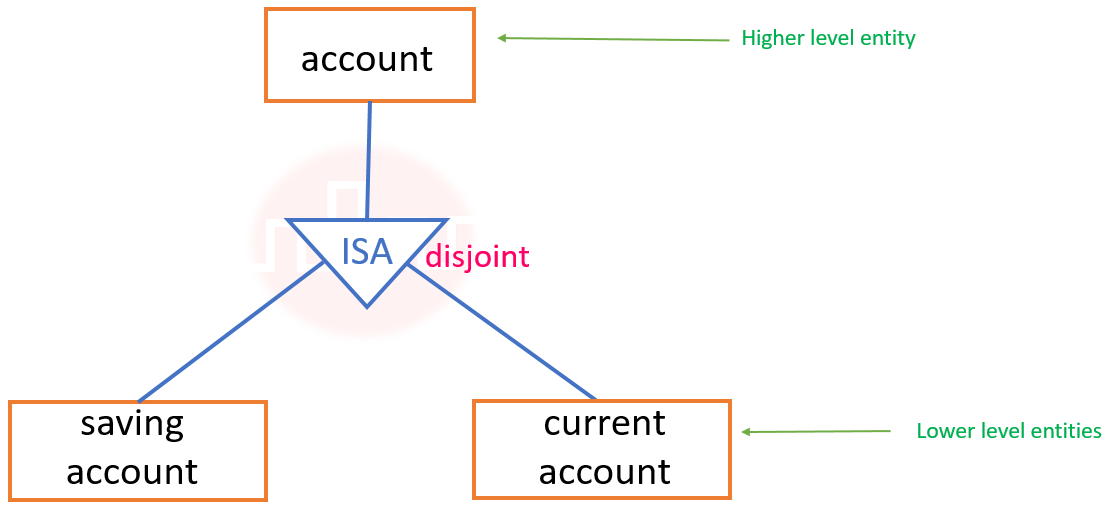 Partial Participation • It is not based on Generization/ Specialization. • The entity in the entity set may or may not participate in the relationship. • Suppose employee entity manages department entity. Here, manages is a relationship between employee and department. Not every employee manage department only manager manages department. So, participation of employee entity is partial.  Total Specialization • Each higher-level entity must belong to a lower-level entity set. • For example, employee must be either teaching faculty or non-teaching faculty or both . Here, employee entity must belong to Lower level entity. 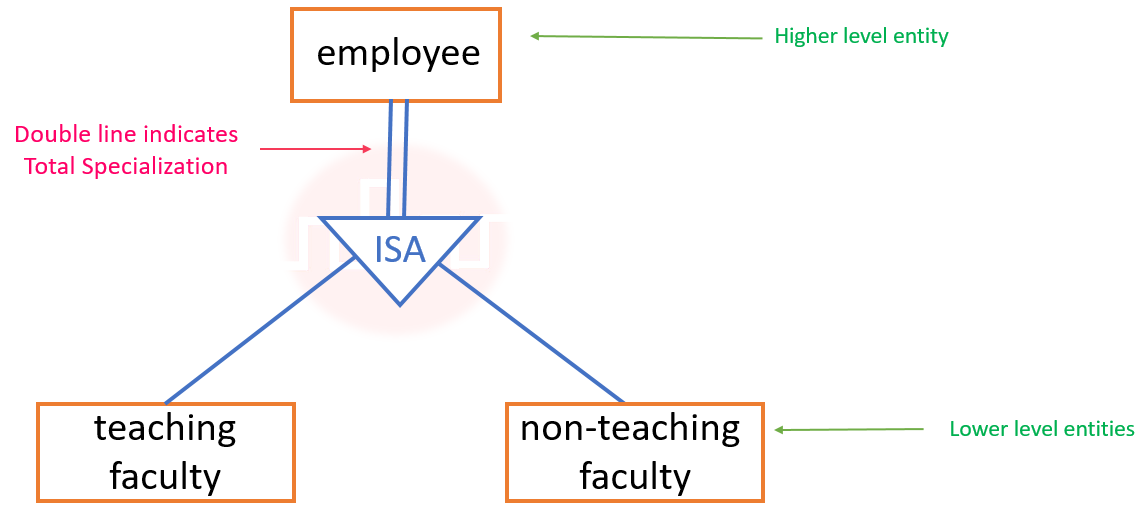 Overlapping Constraints • In overlapping Constraints, the same Higher level entity may belong to more than one lower-level entity set. • For example, person entity may belong to both customer entitity and employee entity. 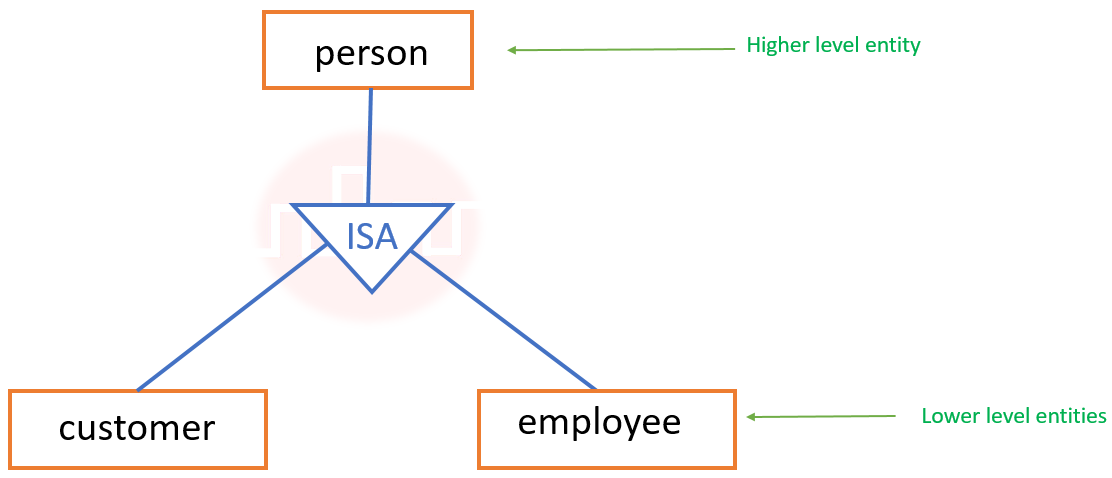 Now come to the question to understand, • One of the Line of question: Each of the part is either manufactured within the company or purchased from the external suppliers or both.point1: part entity either belong to one of the lower level entity or more than one lower level entity. Therefore, Overlapping Constraints need to be considered. point2: part entity must belong to either of the lower level entity. Therefore, Total specialization need to be considered. So, Option(IV) is correct. |
| More Discussion | Explanation On YouTube | E-R Diagram | Help-Line |
| Q.40➡ | NTA UGC NET June 2021 Given a fixed-length record file that is ordered on the key field. The file needs B disk blocks to store R number of records. Find the average access time needed to access any record of the given file using binary search. |
| i ➥ B/2 |
| ii ➥ log2 B |
| iii ➥ B+R |
| iv ➥ B |
Show Answer With Best Explanation
| More Discussion | Explanation On YouTube | Learn Topic Wise | Help-Line |
| Q.41➡ | NTA UGC NET June 2021 The order of a leaf node in a B+ tree is the maximum number of (value, data record pointer) pairs it can hold. Given that the block size is 1K bytes, data record pointer is 7 bytes long, the value field is 9 bytes long and a block pointer is 6 bytes long, what is the order of the leaf node? |
| i ➥ 63 |
| ii ➥ 64 |
| iii ➥ 67 |
| iv ➥ 68 |
Show Answer With Best Explanation
| More Discussion | Explanation On YouTube | Learn Topic Wise | Help-Line |
| Q.42➡ | NTA UGC NET June 2021 Given the following STUDENT-COURSE scheme: STUDENT (Rollno, Name, Courseno) COURSE (Courseno, Coursename, Capacity), where Rollno is the primary key of relation STUDENT and Courseno is the primary key of relation COURSE. Attribute Coursename of COURSE takes unique values only. The number of records in COURSE and STUDENT tables are 3 and 5 respectively. Following relational algebra query is executed: R=STUDENT X COURSE Match List I with List II in context to the above problem statement. 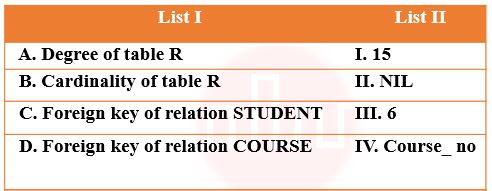 Choose the correct answer from the options given below: |
| i ➥ A -I , B -III , C -IV , D – II |
| ii ➥ A -I , B -III , C -IV , D – II |
| iii ➥ A -I , B -III, C -II , D – IV |
| iv ➥ A -III , B -I , C -IV , D – II |
| Answer – IV Explanation: A. Degree of Table R: The number of Attributes/Column in a table is called Degree of Table.  Degree of Table R is 6. B. Cardinality of Table R: The number of Tuples/records in a table is called Cardinality of Table. Since, The number of records in COURSE and STUDENT tables are 3 and 5 respectively. Cardinality of Table = 3 x 5 = 15 records C. Foreign key of relation STUDENT: Courseno is the primary key of relation COURSE and Courseno is the Foreign key of relation STUDENT. Because Foreign key is an attribute which referred to primary key of another Table. C. Foreign key of relation COURSE: There is no Foreign key in a relation COURSE. So, Option(IV) is correct. |
| More Discussion | Explanation On YouTube | Relational Algebra | Help-Line |
| Q.43➡ | NTA UGC NET June 2021 Given a relation scheme R(x,y,z,w) with functional dependencies set F={x→y, z→w}. All attributes take single and atomic values only. A. Relation R is in First Normal FORM B. Relation R is in Second Normal FORM C. Primary key of R is xz Choose the correct answer from the options given below: |
| i ➥ A and C only |
| ii ➥ B and C only |
| iii ➥ B only |
| iv ➥ C only |
| Answer – I Explanation: Given, Functional dependencies set F={x→y, z→w} (xz)+ = xyzw Therefore, xz is a Candidate key. Concept, First Normal Form: A relation is in first normal form if every field contains only atomic values. Second Normal Form: In 2NF, part of the candidate key should not determined another Attributes( No partial dependency allow). Statement A: Relation R is in First Normal FORM (True) It is given All attributes take single and atomic values only. Therefore, Relation R is in 1NF. Statement B: Relation R is in Second Normal FORM (False) x→y, z→w Here, part of the candidate key (x) determined another attribute y. The Relation have partial Dependency. Therefore, The Relation is not in 2 NF. Statement C: Primary key of R is xz (True) we already seen above, xz is a primary key. So, Option(I) is correct. |
| More Discussion | Explanation On YouTube | Normalization | Help-Line |
| Q.44➡ | NTA UGC NET June 2021 Which of the following is used to create a database schema? |
| i ➥ DDL |
| ii ➥ DML |
| iii ➥ HTML |
| iv ➥ XML |
Show Answer With Best Explanation
| More Discussion | Explanation On YouTube | Learn Topic Wise | Help-Line |
| Q.45➡ | NTA UGC NET June 2021 Consider following two statements: Statement I: Relational database schema represents the logical design of the database. Statement II: Current snapshot of a relation only provides the degree of the relation. In the context to the above statements, choose the correct option from the options given below: |
| i ➥ Both Statement I and Statement II are FALSE |
| ii ➥ Both Statement I and Statement II are TRUE |
| iii ➥ Statement I is FALSE but Statement II is TRUE |
| iv ➥ Statement I is TRUE but Statement II is FALSE |
Show Answer With Best Explanation
| More Discussion | Explanation On YouTube | Relational Model | Help-Line |
| Q.46➡ | NTA UGC NET June 2021 Suppose a B+ tree is used for indexing a database file. Consider the following information: size of the search key field= 10 bytes, block size = 1024 bytes, size of the record pointer= 9 bytes, size of the block pointer= 8 bytes. Let K be the order of internal node and L be the order of leaf node of B+ tree, then (K, L)=_____, |
| i ➥ (34, 31) |
| ii ➥ (50, 52) |
| iii ➥ (57, 53) |
| iv ➥ (60, 64) |
| Answer: III Explaination: Given, Key size = 10 Byte, Block size = 1024 Byte, Record Pointer = 9 Byte, Block Pointer = 8 Byte. Asked, Order of Internal node of B+ Tree = ?, Order of Leaf/External node of B+ Tree = ?. Formula, For Internal node (B+ Tree) n* Block Pointer + (n-1)*Key size <= Block size, For Leaf/External node (B+ Tree) m*(Key size + Record Pointer) + Block Pointer <= Block size. Where, n= order of internal node, m= order of leaf/external node. Calculation, For Internal node (B+ Tree) => n* Block Pointer + (n-1)*Key size <= Block size, => n* 8 + (n-1)*10 <= 1024, => 8n + 10n – 10 <= 1024, => 18n <= 1034, => n <= 57.4 => n = 57 For Leaf/External node (B+ Tree) => m*(10 + 9) + 8 <= 1024, => 19m <= 1016, => m<= 53.4, => m = 53 So, Option(III) (57,53) is correct. |
| More Discussion | Explanation On YouTube | Learn Topic Wise | Help-Line |
Q.47➡ | NTA UGC NET November 2020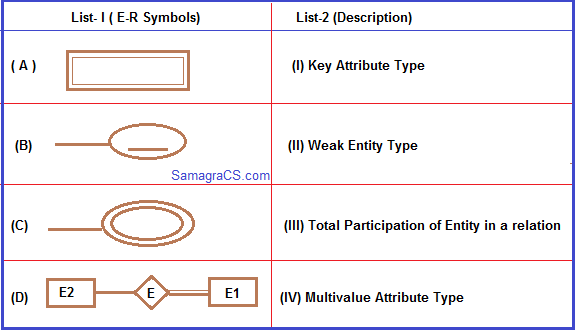 Choose the correct answer from the options given below: |
| i ➥ A-II, B-IV, C-III, D-I |
| ii ➥ A-IV, B-I, C-II, D-III |
| iii ➥ A-II, B-I, C-IV, D-III |
| iv ➥ A-III, B-IV, C-I, D-II |
| Answer – III Explanation: E-R Diagram Notation: 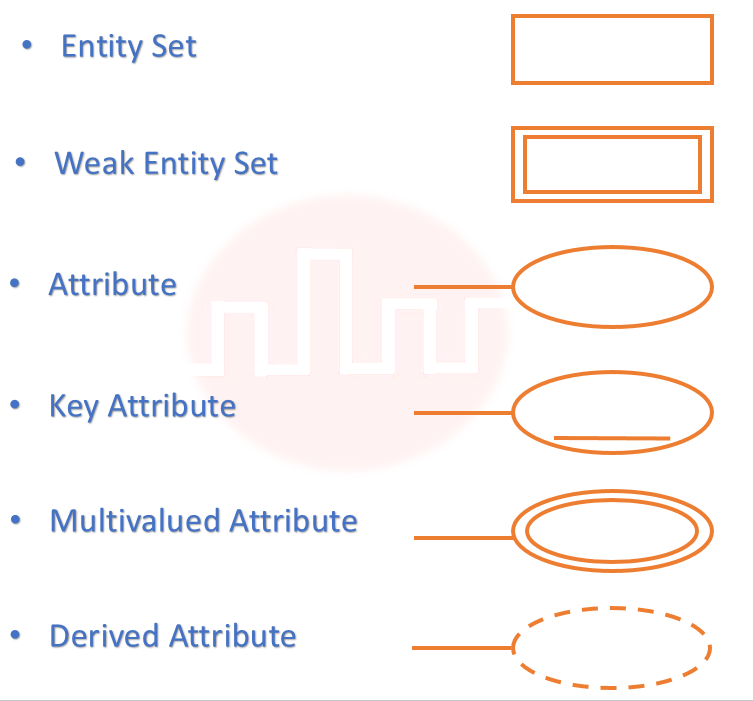 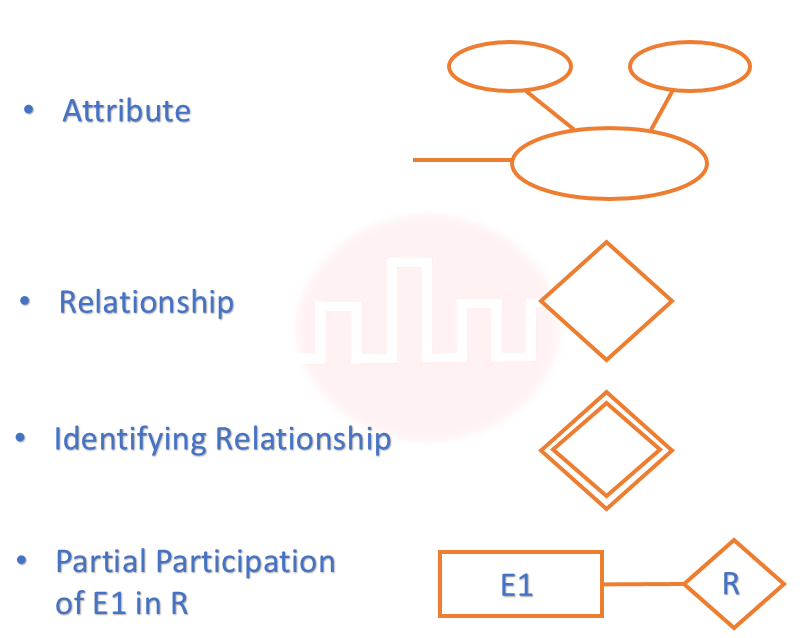  So, Option(III) is correct. |
| More Discussion | Explanation On YouTube | E-R Diagram | Help-Line |
| Q.48➡ | NTA UGC NET November 2020 Given below are two statements: If two variables V1and V2 are used for clustering, then consider the following statements for k means clustering with k=3:- Statement I: If V1and V2 have correlation of 1 the cluster centroid will be in straight line. Statement II: If V1and V2 have correlation of 0 the cluster centroid will be in straight line. In the light of the above statements, choose the correct answer from the options given below: |
| i ➥ Both Statement I and Statement II are true |
| ii ➥ Both Statement I and Statement II are false |
| iii ➥ Statement I is correct but Statement II is false |
| iv ➥ Statement I is incorrect but Statement II is true |
Show Answer With Best Explanation
| More Discussion | Explanation On YouTube | Learn Topic Wise | Help-Line |
| Q.49➡ | NTA UGC NET November 2020 In the context of concurrency control, a given pair of operations in a schedule is called conflict schedule if (A) At level one of the operations is write operations (B) Both the operations are performed on the same data item. (C) Both the operations are performed by different transactions. (D) Both the operations are performed on different data items Choose the correct answer from the options given below: |
| i ➥ (A) and (B) only |
| ii ➥ (A), (B) and (C) only |
| iii ➥ (A), (C) and (D) only |
| iv ➥ (C) and (D) only |
Show Answer With Best Explanation
| More Discussion | Explanation On YouTube | Learn Topic Wise | Help-Line |
| Q.50➡ | NTA UGC NET November 2020 Consider a relational schema S=(U,V,W,X,Y,Z) on which the following functional dependence hold: { U → V, VW → X, Y → W, X → U} Which are the candidate keys among following options? |
| i ➥ UY, VY |
| ii ➥ UY, VY, XY |
| iii ➥ UYZ, VYZ, VWZ |
| iv ➥ UYZ, VYZ, XYZ |
| Answer – IV Explanation: So, Option(IV) is correct. |
| More Discussion | Explanation On YouTube | Relational Algebra | Help-Line |
Q.51➡ | NTA UGC NET November 2020 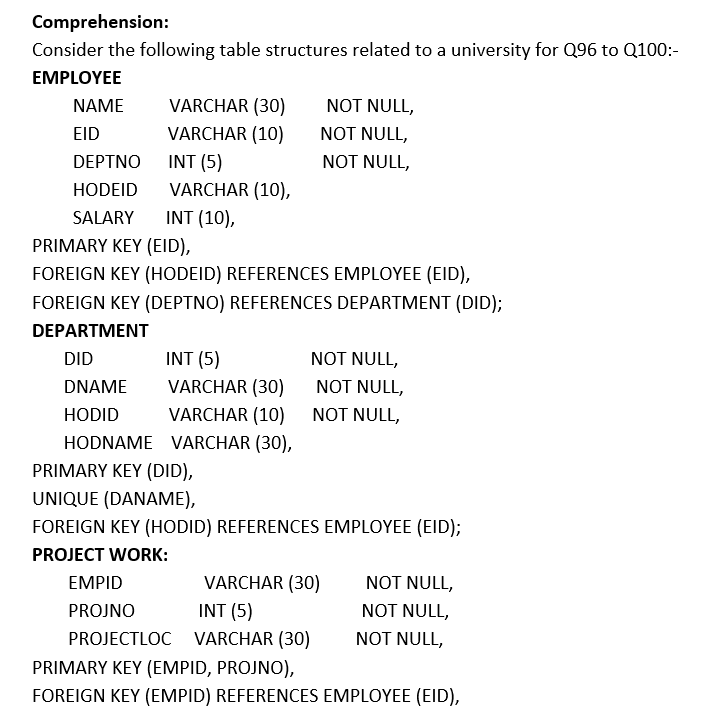 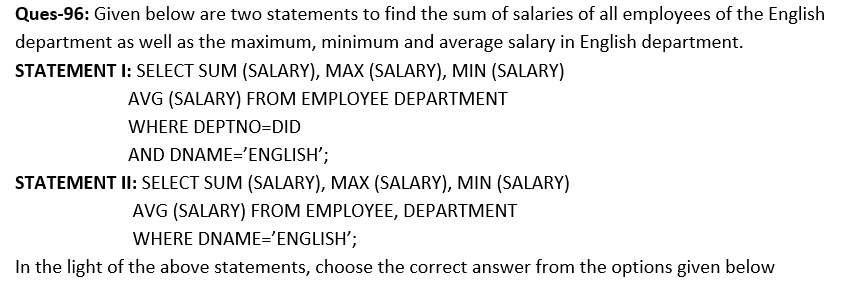 |
| i ➥ Both Statement I and Statement II are true |
| ii ➥ Both Statement I and Statement II are true |
| iii ➥ Statement I is correct but Statement II is false |
| iv ➥ Statement I is incorrect but Statement II is true |
Show Answer With Best Explanation
| More Discussion | Explanation On YouTube | Learn Topic Wise | Help-Line |
Q.52➡ | NTA UGC NET November 2020 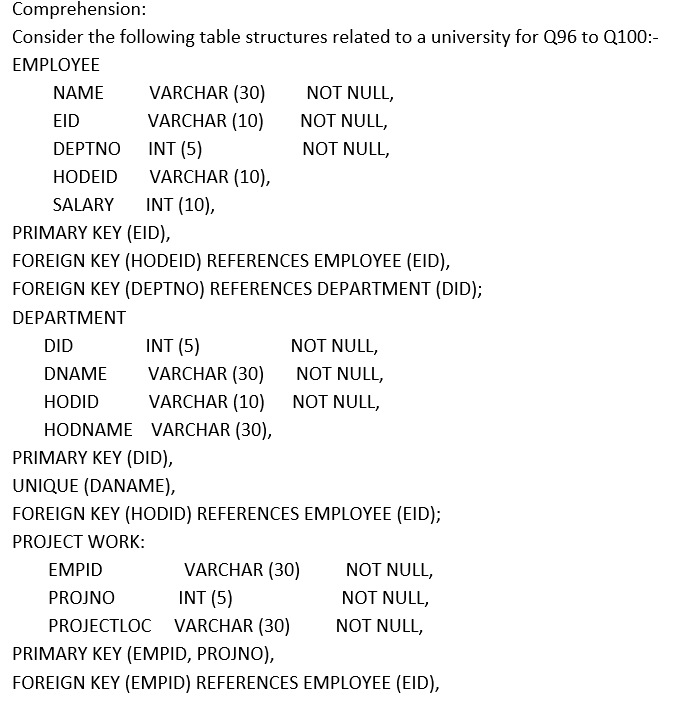 On the basis of above given table structures, retrieve the distinct employee ID (EMPID) of all employees of university who are working on project No. 20, 30 and 40. |
| i ➥ SELECT EMPID FROM PROJECTWORK WHERE PROJNO=(20,30,40); |
| ii ➥ SELECT EMPID FROM PROJECTWORK WHERE PROJNO IN (20,30,40); |
| iii ➥ SELECT DISTINCT EMPID FROM PROJECTWORK WHERE PROJNO IN (20,30,40); |
| iv ➥ SELECT DISTINCT EMPID FROM PROJECTWORK WHERE PROJNO=20,30,40; |
Show Answer With Best Explanation
| More Discussion | Explanation On YouTube | Learn Topic Wise | Help-Line |
Q.53➡ |NTA UGC NET November 2020  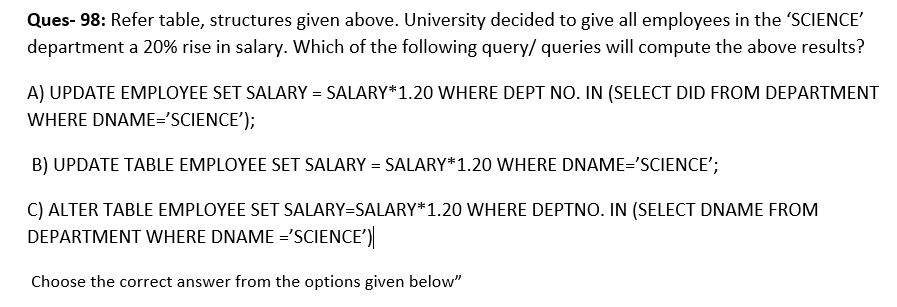 |
| i ➥ (A) and (B) only |
| ii ➥ (A) only |
| iii ➥ (B) and (C) only |
| iv ➥ (C) only |
Show Answer With Best Explanation
| More Discussion | Explanation On YouTube | Learn Topic Wise | Help-Line |
Q.54➡ | NTA UGC NET November 2020  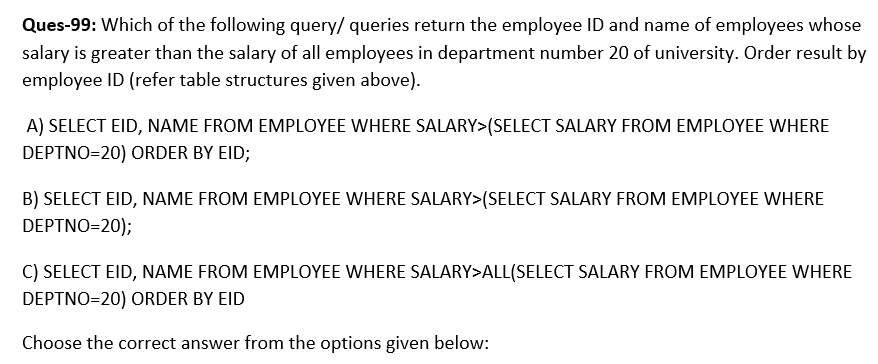 |
| i ➥ (A) and (B) only |
| ii ➥ (A) and (C) only |
| iii ➥ (B) only |
| iv ➥ (C) only |
Show Answer With Best Explanation
| More Discussion | Explanation On YouTube | Learn Topic Wise | Help-Line |
Q.55➡ | NTA UGC NET November 2020   |
| i ➥ (A) and (B) only |
| ii ➥ (A) and (C) only |
| iii ➥ (B) and (C) only |
| iv ➥ (A) only |
Show Answer With Best Explanation
| More Discussion | Explanation On YouTube | Learn Topic Wise | Help-Line |
| Q.56➡ | UGC NET December 2019 Given two tables EMPLOYEE (EID, ENAME, DEPTNO) DEPARTMENT (DEPTNO. DEPTNAME) Find the most appropriate statement of the given query: Select count (*) ‘total’ from EMPLOYEE where DEPTNO IN (D1, D2) group by DEPTNO having count (*) > 5 |
| i ➥ Total number of employees in each department D1 and D2 |
| ii ➥ Total number of employees of department D1 and D2 if their total is >5 |
| iii ➥ Display total number of employees in both departments D1 and D2 |
| iv ➥ The output of the query must have atleast two rows |
Show Answer With Best Explanation
| More Discussion | Explanation On YouTube | Learn Topic Wise | Help-Line |
| Q.57➡ | UGC NET December 2019 Two concurrent executing transactions T1 and T2 are allowed to update same stock item say ‘A’ in an uncontrolled manner. In such a scenario, following problems may occur: (a) Dirty read problem (b) Lost update problem (c) Transaction failure (d) Inconsistent database state Which of the following option is correct if database system has no concurrency module and allow concurrent execution of above two transactions? |
| i ➥ (a), (b) and (c) only |
| ii ➥ (c) and (d) only |
| iii ➥ (a) and (b) only |
| iv ➥ (a), (b) and (d) only |
Show Answer With Best Explanation
| More Discussion | Explanation On YouTube | Learn Topic Wise | Help-Line |
| Q.58➡ | UGC NET December 2019 Find minimum number of tables required for converting the following entity relationship diagram into relational database?  |
| i ➥ 2 |
| ii ➥ 4 |
| iii ➥ 3 |
| iv ➥ 5 |
Show Answer With Best Explanation
| More Discussion | Explanation On YouTube | Learn Topic Wise | Help-Line |
| Q.59➡ | UGC NET December 2019 In a system for a restaurant, the main scenario for placing order is given below: (a) Customer reads menu (b) Customer places an order (c) Order is sent to kitchen for preparation (d) Ordered items are served (e) Customer requests for a bill for the order (f) Bill is prepared for this order (g) Customer is given the bill (h) Customer pays the bill A sequence diagram for the scenario will have at least how many objects among whom the messages will be exchanged. |
| i ➥ 3 |
| ii ➥ 4 |
| iii ➥ 5 |
| iv ➥ 6 |
Show Answer With Best Explanation
| More Discussion | Explanation On YouTube | Learn Topic Wise | Help-Line |
| Q.60➡ | UGC NET December 2019 Given two tables R1(x, y) and R2(y, z) with 50 and 30 number of tuples respectively. Find maximum number of tuples in the output of natural join between tables R1 and R2 i.e. R1 * R2? (*. Natural Join) |
| i ➥ 30 |
| ii ➥ 20 |
| iii ➥ 50 |
| iv ➥ 1500 |
Show Answer With Best Explanation
| More Discussion | Explanation On YouTube | Learn Topic Wise | Help-Line |
| Q.61➡ | UGC NET December 2019 The order of schema?10?101? and ???0??1 are ________and______ respectively. |
| i ➥ 5,3 |
| ii ➥ 5,2 |
| iii ➥ 7,5 |
| iv ➥ 8,7 |
Show Answer With Best Explanation
| More Discussion | Explanation On YouTube | Learn Topic Wise | Help-Line |
| Q.62➡ | UGC NET December 2019 Comprehension: Answer question (27-31) based on the problem statement given below: An organization needs to maintain database having five attributes A, B, C, D, E. These attributes are functionally dependent on each other for which functionally dependency set F is given as : F: {A→ BC, D → E, BC → D, A →D}. Consider a universal relation R(A, B, C, D, E) with functional dependency set F. Also all attributes are simple and take atomic values only. :→ Minimal cover F’ of functional dependency set F is |
| i ➥ F’ = {A → B, A → C, BC → D, D →E} |
| ii ➥ F’ = {A → BC, B → D, D → E} |
| iii ➥ F’ = {A → B, A → C, A → D, D → E} |
| iv ➥ F’ = {A → B, A → C, B → D, C → D,D → E} |
Show Answer With Best Explanation
| More Discussion | Explanation On YouTube | Learn Topic Wise | Help-Line |
| Q.63➡ | UGC NET December 2019 Comprehension: Answer question (27-31) based on the problem statement given below: An organization needs to maintain database having five attributes A, B, C, D, E. These attributes are functionally dependent on each other for which functionally dependency set F is given as : F: {A→ BC, D → E, BC → D, A →D}. Consider a universal relation R(A, B, C, D, E) with functional dependency set F. Also all attributes are simple and take atomic values only. → Assume that given table R is decomposed in two tables R1(A,B,C) with functional dependency set f1={A→ B, A → C} and R2(A,D,E) with functional dependency set f2={A→ D, D → E}. Which of the following option is true w.r.t. given decomposition? |
| i ➥ Dependency preservation property is followed |
| ii ➥ R1 and R2 are both in 2 NF |
| iii ➥ R2 is in 2 NF and R3 is in 3 NF |
| iv ➥ R1 is in 3 NF and R2 is in 2 NF |
Show Answer With Best Explanation
| More Discussion | Explanation On YouTube | Learn Topic Wise | Help-Line |
| Q.64➡ | UGC NET December 2019 Comprehension: Answer question (27-31) based on the problem statement given below: An organization needs to maintain database having five attributes A, B, C, D, E. These attributes are functionally dependent on each other for which functionally dependency set F is given as : F: {A→ BC, D → E, BC → D, A →D}. Consider a universal relation R(A, B, C, D, E) with functional dependency set F. Also all attributes are simple and take atomic values only. → Identify the redundant functional dependency in F |
| i ➥ BC→D |
| ii ➥ D→E |
| iii ➥ A→D |
| iv ➥ A→BC |
Show Answer With Best Explanation
| More Discussion | Explanation On YouTube | Learn Topic Wise | Help-Line |
| Q.65➡ | UGC NET December 2019 Comprehension: Answer question (27-31) based on the problem statement given below: An organization needs to maintain database having five attributes A, B, C, D, E. These attributes are functionally dependent on each other for which functionally dependency set F is given as : F: {A→ BC, D → E, BC → D, A →D}. Consider a universal relation R(A, B, C, D, E) with functional dependency set F. Also all attributes are simple and take atomic values only. → Identify primary key of table R with functional dependency set F |
| i ➥ BC |
| ii ➥ AD |
| iii ➥ A |
| iv ➥ AB |
Show Answer With Best Explanation
| More Discussion | Explanation On YouTube | Learn Topic Wise | Help-Line |
| Q.66➡ | UGC NET December 2019 Comprehension: Answer question (27-31) based on the problem statement given below: An organization needs to maintain database having five attributes A, B, C, D, E. These attributes are functionally dependent on each other for which functionally dependency set F is given as : F: {A→ BC, D → E, BC → D, A →D}. Consider a universal relation R(A, B, C, D, E) with functional dependency set F. Also all attributes are simple and take atomic values only. → Identify the normal form in which relation R belong to |
| i ➥ 1 NF |
| ii ➥ 2 NF |
| iii ➥ 3 NF |
| iv ➥ BCNF |
Show Answer With Best Explanation
| More Discussion | Explanation On YouTube | Learn Topic Wise | Help-Line |
| Q.67➡ | UGC NET JUNE 2019 Which of the following statements are DMl statements? (a) Update [tablename] Set [ columnname] = VALUE (b) Delete [tablename] (c) Select * from [tablename] |
| i ➥ (a) and (b) |
| ii ➥ (a) and (d) |
| iii ➥ (a), (b) and (c) |
| iv ➥ (b) and (c) |
Show Answer With Best Explanation
| More Discussion | Explanation On YouTube | Learn Topic Wise | Help-Line |
| Q.68➡ | UGC NET JUNE 2019 Which of the following key constraints is required for functioning of foreign key in the context of relational database? |
| i ➥ Unique key |
| ii ➥ Primary key |
| iii ➥ Candidate key |
| iv ➥ Check key |
Show Answer With Best Explanation
| More Discussion | Explanation On YouTube | Learn Topic Wise | Help-Line |
| Q.69➡ | UGC NET JUNE 2019 In relational database, if a relation R is in BCNF, then which of the following is true about relation R? |
| i ➥ R is in 4NF |
| ii ➥ R is not in 1NF |
| iii ➥ R is in 2Nf and not in 3NF |
| iv ➥ R is in 2NF and 3NF |
Show Answer With Best Explanation
| More Discussion | Explanation On YouTube | Learn Topic Wise | Help-Line |
| Q.70➡ | UGC NET JUNE 2019 In relational database management, which of the following is/are property/properties of candidate key? P:Uniqueness Q: Irreducibility |
| i ➥ P only |
| ii ➥ Q only |
| iii ➥ Both P and Q |
| iv ➥ Neither P nor Q |
Show Answer With Best Explanation
| More Discussion | Explanation On YouTube | Learn Topic Wise | Help-Line |
| Q.71➡ | UGC NET JUNE 2019 Which of the following features is supported in the relational database model? |
| i ➥ Complex data-types |
| ii ➥ Multivalued attributes |
| iii ➥ Association with multiplicities |
| iv ➥ Generalization relationship |
Show Answer With Best Explanation
| More Discussion | Explanation On YouTube | Learn Topic Wise | Help-Line |
| Q.72➡ | UGC NET JUNE 2019 Following table has two attributes Employee_id and Manager_id, where Employee_id is a primary key and manager_id is a foreign key referencing Employee_id with on-delete cascade: 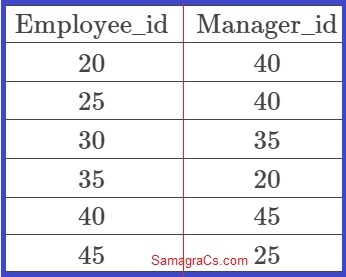 On deleting the table (20,40), the set of other tuples that must be deleted to maintain the referential integrity of table is |
| i ➥ (30,35) only |
| ii ➥ (30,35) and (35,20) only |
| iii ➥ (35,20) only |
| iv ➥ (40,45) and (25,40) only |
Show Answer With Best Explanation
| More Discussion | Explanation On YouTube | Learn Topic Wise | Help-Line |
| Q.73➡ | UGC NET JUNE 2019 With respect to relational algebra, which of the following operations are included from mathematical set theory (a) join (b) Intersection (c) Cartisian product (d) Project |
| i ➥ (a) and (b) |
| ii ➥ (b) and (c) |
| iii ➥ (c) and (d) |
| iv ➥ (b) and (d) |
Show Answer With Best Explanation
| More Discussion | Explanation On YouTube | Learn Topic Wise | Help-Line |
| Q.74➡ | UGC NET JUNE 2019 Which of the following has the same expressive power with regard to relational query language? (a) Relational algebra and Domain relational calculus (b) Relational algebra and Tuple relational calculus (c) Relational algebra and Domain relational calculus restricted to safe expression (d) Relational algebra and Tuple relational calculus restricted to safe expression |
| i ➥ (a) and (b) only |
| ii ➥ (c) and (d) only |
| iii ➥ (a) and (c) only |
| iv ➥ (b) and (d) only |
Show Answer With Best Explanation
| More Discussion | Explanation On YouTube | Learn Topic Wise | Help-Line |
| Q.75➡ | UGC NET December 2018 To overcome difficulties in Readers-Writers problem, which of the following statement/s is/are true? 1) Writers are given exclusive access to shared objects 2) Readers are given exclusive access to shared objects 3) Both readers and writers are given exclusive access to shared objects. Choose the correct answer from the code given below: |
| i ➥ 1 only |
| ii ➥ Both 2 and 3 |
| iii ➥ 2 only |
| iv ➥ 3 only |
Show Answer With Best Explanation
| More Discussion | Explanation On YouTube | Learn Topic Wise | Help-Line |
| Q.76➡ | UGC NET December 2018 Consider the following tables (relations):  Primary keys in the tables are shown using Underline. Now, Consider the following query: SELECT S.Name, Sum (P.Marks) FROM Students S, Performance P WHERE S.Roll-No = P.Roll-No GROUP BY S.Name The number of rows returned by the above query is |
| i ➥ 3 |
| ii ➥ 2 |
| iii ➥ 0 |
| iv ➥ 1 |
Show Answer With Best Explanation
| More Discussion | Explanation On YouTube | Learn Topic Wise | Help-Line |
| Q.77➡ | UGC NET December 2018 Consider the schema R=(A, B, C, D, E, F) on which the following functional dependencies hold : A➝B B,C➝D E➝C D➝A What are the candidate keys of R ? |
| i ➥ AEF, BEF and DEF |
| ii ➥ AEF, BEF and BCF |
| iii ➥ AE and BE |
| iv ➥ AE, BE and DE |
Show Answer With Best Explanation
| More Discussion | Explanation On YouTube | Learn Topic Wise | Help-Line |
| Q.78➡ | UGC NET December 2018 An attribute A of data type varchar(20) has the value ‘xyz’ and attribute B of data type char(20) has the value “Imnop” , then the attribute A has spaces and attribute B has spaces. |
| i ➥ 20 , 20 |
| ii ➥ 3, 20 |
| iii ➥ 3, 5 |
| iv ➥ 20, 5 |
Show Answer With Best Explanation
| More Discussion | Explanation On YouTube | Learn Topic Wise | Help-Line |
| Q.79➡ | UGC NET December 2018 Consider the following sequence of two transactions on a bank account(A) with initial balance 20,000 that transfers 5,000 to another account (B) and then apply 10% interest. (i) T1 start (ii) T1 A old=20000 new 15,000 (iii) T1 B old=12000 new=17000 (iv) T1 commit (v) T2 start (vi) T2 A old=15000 new=16500 (vii) T2 commit Suppose the database system crashes out just before log record (vii) is written. When the system is restricted, which one statement is true of the recovery process ? |
| i ➥ We can apply redo and undo operation in arbitrary order because they are idempotent. |
| ii ➥ We must redo log record (vi) to set A to 16,500. |
| iii ➥ We must undo log record (vi) to set A to 16,500 and then redo log record (ii) and (iii). |
| iv ➥ We need not redo records (ii) and (iii) because transaction T1 has committed. |
Show Answer With Best Explanation
| More Discussion | Explanation On YouTube | Learn Topic Wise | Help-Line |
| Q.80➡ | UGC NET December 2018 The clustering index is defined on the fields which are of type |
| i ➥ key and ordering |
| ii ➥ key and non-ordering |
| iii ➥ non-key and ordering |
| iv ➥ non-key and non-ordering |
Show Answer With Best Explanation
| More Discussion | Explanation On YouTube | Learn Topic Wise | Help-Line |
| Q.81➡ | UGC NET December 2018 _________ command is used to remove a relation from an SQL database. |
| i ➥ Update table |
| ii ➥ Remove table |
| iii ➥ Delete table |
| iv ➥ Drop table |
Show Answer With Best Explanation
| More Discussion | Explanation On YouTube | Learn Topic Wise | Help-Line |
| Q.82➡ | UGC NET JUNE 2018 In RDBMS, which type of Join returns all rows that satisfy the join condition ? |
| i ➥ Inner Join |
| ii ➥ Outer Join |
| iii ➥ Semi Join |
| iv ➥ Anti Join |
Show Answer With Best Explanation
| More Discussion | Explanation On YouTube | Learn Topic Wise | Help-Line |
| Q.83➡ | UGC NET JUNE 2018 Consider a relation book(title, price) which contains the titles and prices of different books. Assuming that no two books have the same price, what does the following SQL query list ? SELECT title FROM book AS B WHERE(SELECT COUNT(*) FROM book AS T WHERE T.price > B.price) < 7 |
| i ➥ Titles of the six most expensive books. |
| ii ➥ Title of the sixth most expensive books. |
| iii ➥ Titles of the seven most expensive books. |
| iv ➥ Title of the seventh most expensive books. |
Show Answer With Best Explanation
| More Discussion | Explanation On YouTube | Learn Topic Wise | Help-Line |
| Q.84➡ | UGC NET JUNE 2018 In a Hierarchical database, a hashing function is used to locate the . |
| i ➥ Collision |
| ii ➥ Root |
| iii ➥ Foreign Key |
| iv ➥ Records |
Show Answer With Best Explanation
| More Discussion | Explanation On YouTube | Learn Topic Wise | Help-Line |
| Q.85➡ | UGC NET JUNE 2018 Relations produced from E-R Model will always be in . |
| i ➥ 1 NF |
| ii ➥ 2 NF |
| iii ➥ 3 NF |
| iv ➥ 4 NF |
Show Answer With Best Explanation
| More Discussion | Explanation On YouTube | Learn Topic Wise | Help-Line |
| Q.86➡ | UGC NET JUNE 2018 Consider the following schedules involving two transactions. S1: r1(X) ; r1(Y) ; r2(X) ; r2(Y) ; w2(Y) ; w1(X) S2 : r1(X) ; r2(X) ; r2(Y) ; w2(Y) ; r1(Y) ; w1(X) Which one of the following statements is correct with respect to above ? |
| i ➥ Both S1 and S2 are conflict serializable. |
| ii ➥ Both S1 and S2 are not conflict serializable. |
| iii ➥ S1 is conflict serializable and S2 is not conflict serializable. |
| iv ➥ S1 is not conflict serializable and S2 is conflict serializable. |
Show Answer With Best Explanation
| More Discussion | Explanation On YouTube | Learn Topic Wise | Help-Line |
| Q.87➡ | UGC NET JUNE 2018 For a database relation R(a, b, c, d) where the domains of a, b, c and d include only atomic values, and only the following functional dependencies and those that can be inferred from them hold : a → c b → d The relation is in . |
| i ➥ First normal form but not in second normal form |
| ii ➥ Second normal form but not in third normal form |
| iii ➥ Third normal form |
| iv ➥ BCNF |
Show Answer With Best Explanation
| More Discussion | Explanation On YouTube | Learn Topic Wise | Help-Line |
| Q.88➡ | UGC NET JUNE 2018 A many-to-one relationship exists between entity sets r1 and r2. How will it be represented using functional dependencies if Pk(r) denotes the primary key attribute of relation r? |
| i ➥ Pk(r1 ) → Pk(r2 ) |
| ii ➥ Pk(r2 ) → Pk(r1 ) |
| iii ➥ Pk(r2 ) → Pk(r1 ) and Pk(r1 ) → Pk(r2 ) |
| iv ➥ Pk(r2 ) → Pk(r1 ) or Pk(r1 ) → Pk(r2 ) |
Show Answer With Best Explanation
| More Discussion | Explanation On YouTube | Learn Topic Wise | Help-Line |
| Q.89➡ | UGC NET JUNE 2018 Database systems that store each relation in a separate operating system file may use the operating system’s authorization scheme, instead of defining a special scheme themselves. In this case, which of the following is false ? |
| i ➥ The administrator enjoys more control on the grant option. |
| ii ➥ It is difficult to differentiate among the update, delete and insert authorizations. |
| iii ➥ Cannot store more than one relation in a file |
| iv ➥ Operations on the database are speeded up as the authorization procedure is carried out at the operating system level. |
Show Answer With Best Explanation
| More Discussion | Explanation On YouTube | Learn Topic Wise | Help-Line |
| Q.90➡ | UGC NET JUNE 2018 Let R1(a,b,c) and R2(x,y,z) be two relations in which a is the foreign key of R1 that refers to the primary key of R2 . Consider following four options. (a) Insert into R1 (b) Insert into R2 (c) Delete from R1 (d) Delete from R2 Which of the following is correct about the referential integrity constraint with respect to above ? |
| i ➥ Operations (a) and (b) will cause violation. |
| ii ➥ Operations (b) and (c) will cause violation. |
| iii ➥ Operations (c) and (d) will cause violation. |
| iv ➥ Operations (d) and (a) will cause violation. |
Show Answer With Best Explanation
| More Discussion | Explanation On YouTube | Learn Topic Wise | Help-Line |
| Q.91➡ | UGC NET November 2017 Paper-II Which of the following is/are true with reference to ‘view’ in DBMS ? (a) A ‘view’ is a special stored procedure executed when certain event occurs. (b) A ‘view’ is a virtual table. which occurs after executing a pre-compiled query. code: |
| i ➥ Only (a) is true |
| ii ➥ Only (b) is true |
| iii ➥ Both (a) and (b) are true |
| iv ➥ Neither (a) nor (b) are true |
Show Answer With Best Explanation
| More Discussion | Explanation On YouTube | Learn Topic Wise | Help-Line |
| Q.92➡ | UGC NET November 2017 Paper-II In SQL, __ is an Aggregate function. |
| i ➥ SELECT |
| ii ➥ CREATE |
| iii ➥ AVG |
| iv ➥ MODIFY |
Show Answer With Best Explanation
| More Discussion | Explanation On YouTube | Learn Topic Wise | Help-Line |
| Q.93➡ | UGC NET November 2017 Paper-II Match the following with respect to RDBMS :  Code: |
| i ➥ (a)-(iii), (b)-(iv), (c)-(i), (d)-(ii) |
| ii ➥ (a)-(iv), (b)-(iii), (c)-(ii), (d)-(i) |
| iii ➥ (a)-(iv), (b)-(ii), (c)-(iii), (d)-(i) |
| iv ➥ (a)-(ii), (b)-(iii), (c)-(iv), (d)-(i) |
Show Answer With Best Explanation
| More Discussion | Explanation On YouTube | Learn Topic Wise | Help-Line |
| Q.94➡ | UGC NET November 2017 Paper-II In RDBMS, different classes of relations are created using ________ technique to prevent modification anomalies. |
| i ➥ Functional Dependencies |
| ii ➥ Data integrity |
| iii ➥ Referential integrity |
| iv ➥ Normal forms |
Show Answer With Best Explanation
| More Discussion | Explanation On YouTube | Learn Topic Wise | Help-Line |
| Q.95➡ | UGC NET November 2017 Paper-II ______ SQL command changes one or more fields in a record. |
| i ➥ LOOK-UP |
| ii ➥ INSERT |
| iii ➥ MODIFY |
| iv ➥ CHANGE |
Show Answer With Best Explanation
| More Discussion | Explanation On YouTube | Learn Topic Wise | Help-Line |
| Q.96➡ | UGC NET November 2017 Paper-III Consider the following four schedules due to three transactions (indicated by the subscript) using read and write on a data item X, denoted by r(X) and w(X) respectively. Which one of them is conflict serializable ? S1: r1(X); r2(X); w1(X); r3(X); w2(X) S2: r2(X); r1(X); w2(X); r3(X); w1(X) S3: r3(X); r2(X); r1(X); w2(X); w1(X) S4: r2(X); w2(X); r3(X); r1(X); w1(X) |
| i ➥ S1 |
| ii ➥ S2 |
| iii ➥ S3 |
| iv ➥ S4 |
Show Answer With Best Explanation
| More Discussion | Explanation On YouTube | Learn Topic Wise | Help-Line |

